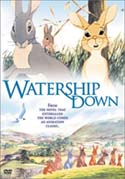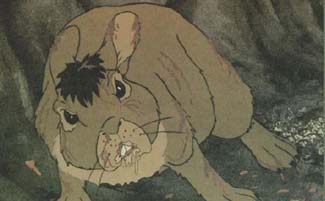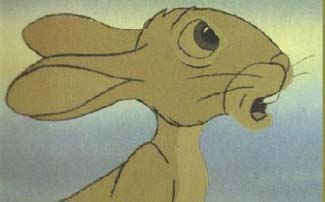|
Like one of their many
overdrawn villains, the Walt Disney feature film machine
is too big, too powerful, and too maniacally prevalent
to allow much in the way of competition. And when a bold
hero does manage to wound the mighty beast with a show
of spunk and creativity, he is rewarded by being incorporated—like
the computer animation company Pixar, who’s first
feature-length film was not "Pixar’s Toy
Story," but "Disney’s Toy Story."
In the late 1970’s,
Disney released a series of lackluster animated features,
including The Aristocats, Robin Hood, and
The Many Adventures of Winnie the Pooh. Perhaps
noticing this, Warner Brothers decided the time was right
to take a chance on producer/director Martin Rosen’s
vision for the beloved Richard Adams novel Watership
Down. The striking 1978 promotional artwork of a silhouetted
rabbit against a night sky announced that this would not
be a children’s picture, as did the tagline: "All
the world will be your enemy, Prince with a thousand enemies,
and when they catch you they will kill you."
 |
Unlike today’s non-Disney
films, all of which succeed only by imitating the Disney
formula, Watership Down was its own invention.
The story was simple: relying on the ominous vision of
a rabbit named Fiver, a group of bunnies flee from their
doomed warren, and trek across the countryside to a safer
haven. In order to gather does for mating, the rabbits
infiltrate a nearby warren run by the fascist General
Woundwort, and make a daring escape with a bunch of females.
Thus, the story of their leader, Hazel, becomes bunny
legend.
Out of necessity,
the novel’s plot was greatly reduced, turning an
epic adventure into a short series of brief escapades.
But Rosen nailed the severe, sad, intelligent—even
mythic—tone of the book. This was accomplished by
stubbornly maintaining the film’s status as a drama.
There are no wisecracking sidekicks; there are no harmonizing
forest animals. Although the animals are physically cute,
never are they REALLY cute—their wise, English voices
and constant struggle for survival give them each a dignity
reserved for only the most lofty of Disney characters
(the Evil Queen in Snow White; Mufasa in The
Lion King).
Like other great children’s
films (Willy Wonka and the Chocolate Factory; The
Wizard of Oz), Watership Down used imagery
that seared in the minds of those who saw it as children.
There are several experimental sequences that communicate
great tragedy and massive death by bleeding and folding
one image into another: the sun drips blood to intimate
the devastation of the warren; a horrifying swirl of images
illustrates how men fill in the warren holes and the dead
bodies of the rabbits clog the tunnels; tractors rip apart
the soil like bleeding wounds into flesh; the "Black
Rabbit of Death" floats across the hillside, coming
to silently snatch the soul of another rabbit. These images
were all the more unsettling when seen against the beautiful,
muted watercolor paintings that made up the majority of
the scenery.
 |
The film’s most shocking
element was the large amount of animal violence, the sort
of which would never pass censors today. Rabbits are caught
in snares, tortured in slow-motion and fight each other
to the death, their furious spittle mixing with their
gushing blood. If Bambi showed kids the sadness
of death, Watership Down showed them the blunt
brutality of it.
The world, said Watership
Down, was ugly. The myriad predators, with their sparkling
eyes and blood-soaked fangs, were terrifying. Our heroes
encounter a warren of rabbits who’ve accepted their
supine role as being food for other animals, quoting dark
poetry about accepting one’s fate. But balancing
Watership Down’s
ugliness was a beautiful, gentle belief in the life cycle—when
the Black Rabbit of Death finally comes for Hazel, it
is inspiring rather than frightening. Even the one song
in the film, the melancholy "Bright Eyes" by
Art Garfunkel, is an oddly perfect fit.
 |
The only disappointing
thing about Watership Down is that is missed its
chance to set the bar for adult animated features. The
movie feels like a film that has been edited-for-TV; each
adventure feels unfairly truncated. In many ways, Watership
Down—both the book and the movie—resemble
other classic works whose popularity stretches across
age barriers. Like Star Wars, it is a story of
a brave rebellion against ruthless tyranny. Like Tolkein’s
The Lord of the Rings, it is a Homeric journey
of sacrifice and self-discovery.
Watership Down was
not a complete success, but it possesses more genuine
moments of beauty and sadness than any animated feature
in the last thirty years, and harkens back to a time when
animation represented the cutting edge of storytelling—instead
of the status quo.
|